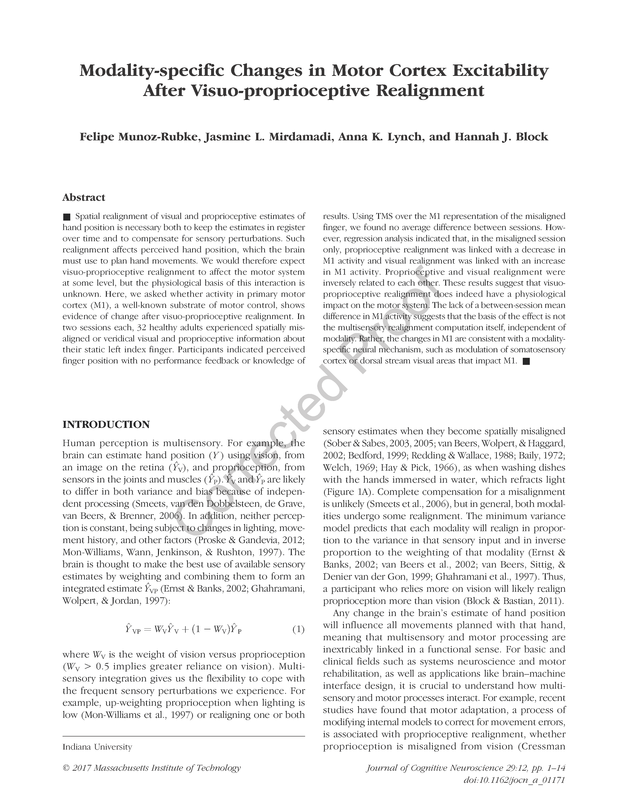|
From the NSF award listing:
Award Abstract #1753915 Reciprocal effects of adaptation in the brain's motor and sensory systems NSF Org:BCS Division Of Behavioral and Cognitive Sci Initial Amendment Date:February 1, 2018 Latest Amendment Date:February 1, 2018 Award Number:1753915 Award Instrument:Continuing grant Program Manager:Betty H. Tuller BCS Division Of Behavioral and Cognitive Sci SBE Direct For Social, Behav & Economic Scie Start Date:May 1, 2018 End Date:April 30, 2021 (Estimated) Awarded Amount to Date:$173,878.00 Investigator(s):Hannah Block [email protected] (Principal Investigator) Sponsor:Indiana University 509 E 3RD ST Bloomington, IN 47401-3654 (812)855-0516 NSF Program(s):PERCEPTION, ACTION & COGNITION Program Reference Code(s):7252 Program Element Code(s):7252 ABSTRACT This project will investigate the complex interactions between how we perceive the world around us and how we move within that world. The researchers will test how learning a new skill affects the information picked up from the world and how that information, in turn, affects motor learning. Understanding the relationship between perception and movement control is fundamental for many fields. Results could contribute to innovations in motor skill training, including rehabilitation of sensorimotor disorders after stroke and development of prostheses, as well as to ergonomics, brain-machine interfaces, robotics, and tele-operations. The project will advance the NSF's educational goals by encouraging underrepresented students to consider STEM career paths. Five undergraduates per year will be involved in all aspects of the research, including at least three women and minorities through partnerships with programs at Indiana University. The project will also support the expansion of a neuroscience summer camp developed by the study team for Indiana high school girls. To execute a voluntary movement, such as reaching out to pick up a pencil, the brain must plan motor parameters such as movement direction and extent. Importantly, the hand's movement will not be correct unless the brain accurately perceives hand position, obtained through an integration of visual information, body position sense (proprioception), touch, etc. This "multisensory integration" is flexible and can change with learning, just like motor control, but it is not known whether or how these processes interact. The project will address this question at both the behavioral and neural levels and asks whether multisensory integration and motor control share a common sensorimotor map (a model relating motor commands to sensory consequences). A combination of psychophysics and reaching tasks will indicate whether multisensory integration and motor learning affect each other at the behavioral level. Using transcranial magnetic stimulation (TMS), the researchers will examine whether connections between sensory and motor areas of the brain change in strength when subjects learn a new spatial relationship between vision and proprioception; this would suggest a shared sensorimotor map at the neural level. Results will inform a theoretical framework of sensorimotor control that accounts for both multisensory integration and motor learning. This award reflects NSF's statutory mission and has been deemed worthy of support through evaluation using the Foundation's intellectual merit and broader impacts review criteria. Cerebellar-M1 connectivity changes associated to motor learning are
somatotopic specific D. Spampinato, H.J. Block and P. Celnik Journal of Neuroscience 30 January 2017, 2511-16; DOI: https://doi.org/10.1523/JNEUROSCI.2511-16.2017 One of the functions of the cerebellum in motor learning is to predict and account for systematic changes to the body or environment. This form of adaptive learning is mediated by plastic changes occurring within the cerebellar cortex. The strength of cerebellar-to- cerebral pathways for a given muscle may reflect aspects of cerebellum-dependent motor adaptation. These connections with motor cortex (M1) can be estimated as cerebellar inhibition (CBI): a conditioning pulse of transcranial magnetic stimulation (TMS) delivered to the cerebellum prior to a test pulse over motor cortex. We have previously shown changes in CBI for a given muscle representation correlate with learning a motor adaptation task with the involved limb. However, the specificity of these effects is unknown. Here, we asked whether CBI changes in humans are somatotopy-specific and how they relate to motor adaptation. We found that learning a visuomotor rotation task with the right hand changed CBI not only for the involved first dorsal interosseous (FDI) of the right hand, but also for an uninvolved right leg muscle, tibialis anterior (TA), likely related to inter-effector transfer of learning. In two follow-up experiments, we investigated whether the preparation of a simple hand or leg movement would produce a somatotopy-specific modulation of CBI. We found that CBI changes only for the effector involved in the movement. These results indicate that learning-related changes in cerebellar-M1 connectivity reflect a somatotopy-specific interaction. Modulation of this pathway is also present in the context of inter-limb transfer of learning. SIGNIFICANCE STATEMENT Connectivity between the cerebellum and motor cortex is a critical pathway for the integrity of everyday movements, and understanding the somatotopic specificity of this pathway in the context of motor learning is critical to advancing the efficacy of neuro-rehabilitation. We found that adaptive learning with the hand affects cerebellar-motor cortex connectivity not only for the trained hand, but also for an untrained leg muscle, an effect likely related to inter-effector transfer of learning. Furthermore, we introduce a novel method to measure cerebellar-motor cortex connectivity during movement preparation. With this technique we show that outside the context of learning, modulation of cerebellar-motor cortex connectivity is somatotopically specific to the effector being moved. Hoseini, N., Munoz, L.F., Wan, H.Y., Block, H.J. (2016). Motor point associative stimulation (MPAS) and transcranial direct current stimulation (tDCS) over sensorimotor cortex to improve manual dexterity. Neuroscience Letters: epub ahead of print.
PhD student Jasmine Mirdamadi wrote a NeuroForum review article titled "Cerebellar role in Parkinson's disease" as part of her course work for SPH-K 543 last fall. It just came out. Congratulations, Jasmine!
There are two undergraduate research events on campus this weekend, and we have a student presenting in each.
The Block Lab congratulates Jasmine Mirdamadi, one of our PhD students, on her successful application to the National Science Foundation (NSF) Graduate Research Fellowship Program (GRFP)! https://www.nsfgrfp.org/ https://info.publichealth.indiana.edu/releases/iub/sph/2016/10/NSF_graduate_student_fellowship.shtml |
Archives
July 2019
Categories |








 RSS Feed
RSS Feed